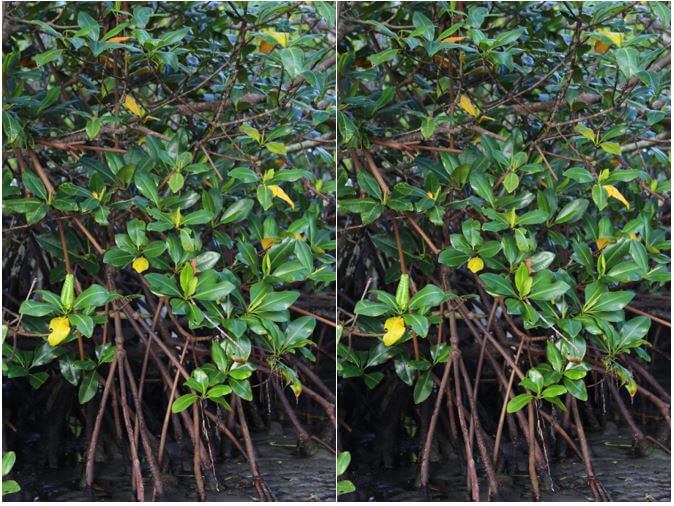Mangroves are trees or shrubs that are found in the intertidal zone of coastlines, or that area between the coastal environment and the terrestrial environment. Mangrove trees are equipped with impressive filtration systems that allow them to filter out or exclude salt altogether, despite their twice-daily inundation by saltwater due to changing tides. Perhaps their most notable feature, mangroves have complex root systems that extend above and below the water line. These roots allow mangroves to stabilise themselves and prevent erosion to the coastline, and also provide habitat, nurseries, and feeding grounds for a vast array of fish and other organisms.
Yet mangroves are disappearing three to five times faster than overall global forest losses, with serious ecological and socio-economic impacts. Current estimates indicate that mangrove coverage has been divided by two in the past 40 years.
The world area of mangroves has been recently mapped at 152,000 km2 (Spalding et al., 2010). In the Pacific Islands region, the total mangrove area is nearly 5,687 km, or 3.74% of the world’s mangroves, with the largest areas in Papua New Guinea, Solomon Islands, Fiji and New Caledonia.
Pacific Islander societies have traditionally been based in coastal resource management, with many early settlements close to mangrove areas. They continue to provide significant social, economic and cultural benefits for the people of the Pacific Islands.
Mangroves are disappearing at an alarming rate with serious ecological and socio-economic impacts. According to a study by Cameron et al. (2021), the greatest drivers of mangrove loss are increasing frequency and intensity of natural disasters such as tropical cyclones and flooding, coastal reclamation for unsustainable aquaculture and infrastructure development, and overexploitation of mangrove resources.
In Samoa, mangrove ecosystems are rapidly declining due to reclamation, urban and tourism development, and land-based activities such as agriculture, aquaculture and pollution. Consequently, there is increased loss of important environmental and economic goods and services such as forest products, flood mitigation and habitat for fish.
In Tonga, mangroves of the surveyed area in Fanga’uta lagoon needed further investigation to establish the cause of reduced mangrove condition along the mangrove fringe. A combination of both natural (cyclones) and anthropogenic (road construction) factors may be affecting mangrove condition. The bund wall can be the cause of altering hydrology to adjacent mangrove areas and efforts should be undertaken to restore tidal flow.
In Fiji, in Rewa Delta, some of the key challenges to the sustainability of the mangrove system include:
• Illegal cutting of mangrove forest by outsiders,
• Absence of sustainable harvesting approaches in communities,
• Lack of awareness of the importance of the mangrove system and the resources associated with it,
• Increase in population which has resulted in the need for more mangrove fuel wood,
• Use of mangrove bark for traditional herbal medicine and dye resulting in the destruction of these trees,
• Greater impacts of king tides,
• Communities in this region starting to experience scarcity in marine resource stock,
• Improper disposal of village solid and liquid waste.
Mangroves are recognised as the most productive nature-based solution due to the goods and services it provides yearly. Action must be taken to protect and properly manage our mangrove ecosystem.
In the efforts to combat this loss and fast-track better management practices, the International Union Conservation for Nature – Oceania Regional Office (IUCN Oceania) became a founding member of the Global Mangrove Alliance (GMA) and the focal point for the Community of Ocean Action (COA) on Mangroves with the Ramsar secretariat.
IUCN Oceania has also facilitated several mangrove restoration projects such as the Mangrove Ecosystems for Climate Change Adaptation & Livelihoods (MESCAL) Project in Fiji, Vanuatu, Samoa, Solomon Islands and Tonga from 2009-2013; the Mangrove Rehabilitation for Sustainably Managed Healthy Forests (MARSH) Project in PNG in 2013-2015; and the Red List of Ecosystem (RLE) Risk Assessment of mangroves on Tongatapu in Tonga 2019-2021.
Those listed projects have been completed however, IUCN Oceania has several current projects that could fund mangrove related work such as the Kiwa Initiative, Biodiversity and Protected Areas Management (BIOPAMA) and the Green Climate Fund (GCF) Coastal and Marine Ecosystem Resilience Programme (CMERP) projects.
Furthermore, the BIODEV 2030 project under IUCN Oceania encourages business to make voluntary commitments to reduce pressures on biodiversity over the next decade. Such voluntary contributions will be a big step towards building ambitious common goals to halt the decline in biodiversity by 2030 and restore biodiversity by 2050.
Halting mangrove loss is essential to prevent further mangrove loss, degradation, and fragmentation to ensure the persistence of healthy, intact mangrove ecosystems and the ecosystem services they provide.



